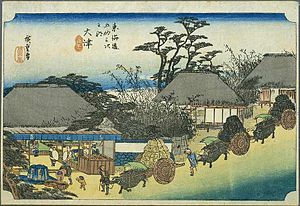Ōtsu-juku (
Ōtsu-juku | |||||
|---|---|---|---|---|---|
| post station | |||||
 Hiroshige's print of Ōtsu-juku, in The Fifty-three Stations of the Tōkaidō series | |||||
| General information | |||||
| Location | Ōtsu, Shiga (former Ōmi Province) Japan | ||||
| Coordinates | 35°00′21.5″N 135°51′41.1″E / 35.005972°N 135.861417°E | ||||
| Elevation | 105 meters | ||||
| Line(s) | Tōkaidō Nakasendō | ||||
| Distance | 495.5 km from Edo | ||||
| |||||

History
editThe road through Ōtsu-juku is flat and runs along the bank of Lake Biwa, passing the jōkamachi of Zeze Domain. Before entering Ōtsu-juku, the road made several double-bends intended to slow down any attacker in front of Zeze Castle. Ōtsu had been the capital of Japan briefly in the 7th century and was an important town due to its location on the outlet Lake Biwa via the Seta River, which becomes the "Uji River" is Kyoto and the "Yodo River" in Osaka. A famous ancient Chinese-style bridge crossed the river at this point. This bridge was much celebrated in literature and marked the edge of the capital region.
Per the 1843 "
Ōtsu-juku was also the starting point for the Ōsaka Kaidō, an extension of the Tōkaidō which bypassed Kyoto and passed through Fushimi, Hirakata and Moriguchi to central Osaka.
Ōtsu-juku in The Sixty-nine Stations of the Kiso Kaidō
editUtagawa Hiroshige's ukiyo-e print of Ōtsu-juku dates from 1835–1838. The print depicts the main street of Ōtsu-juku, Hacho-dori, which slopes down to Lake Biwa. Heavily-laden oxcarts are ascending the street, which draw the attention of three traveling women heading in the opposite direction. The opened-fronted shop of the left contains a kago (palanquin), with two bearers in front, hoping for customers. The shops on both sides of the street have signs with various letters or symbols representing Hiroshige and/or his publisher. Overhead, migrating flocks of birds indicate that the scene is set in autumn.
Ōtsu-juku in The Fifty-three Stations of the Tōkaidō
editUtagawa Hiroshige's ukiyo-e Hōeidō edition print of Ōtsu-juku dates from 1833–1834. The print again depicts oxcarts, heavily laden with bushels of rice or charcoal, but this time descending the street. The oxcarts pass in front of the open front of the Hashirii teahouse, which was a popular resting point on the highway, and which served Hashirii Mochi (
Neighboring post towns
edit- Nakasendō & Tōkaidō
- Kusatsu-juku - Ōtsu-juku - Sanjō Ōhashi
- Ōsaka Kaidō (extended Tōkaidō)
- Kusatsu-juku - Ōtsu-juku - Fushimi-juku
Notes
edit- ^ Tōkaidō 53: Ōtsu-juku. Kōhei Wada. Accessed July 17, 2007.
References
edit- Berna, Cristina (2020). Hokusai 53 Stations of the Tōkaidō 1805-1806. Missys Clan. ISBN 1649454767.
- Yagi, Makio (2019).
新版 ちゃんと歩 ける東海道 五 十 三 次 西 見付 宿 ~京 三条 大橋 +佐屋 街道 .山 と渓谷社 . ISBN 4635600874.(in Japanese) - Sasaki, Moritoshi (2010).
歌川 広重 保永 堂 版 東海道 五拾 三 次 (謎 解 き浮世絵 叢書 ). Nigensha. ISBN 4544212014.(in Japanese) - Izzard, Sebastian (2008). The Sixty-Nine Stations of the Kisokaido. George Braziller. ISBN 0807615935.
- Berna, Cristina (2019). Hiroshige 69 Stations of the Nakasendō. Missys Clan. ISBN 2919787667.
- Kishimoto, Yutaka (2016).
中山道 浪漫 の旅 書 き込 み手帖 . Shinano Mainichi Shimbun. ISBN 4784072977.(in Japanese) - Yagi, Makio (2014). ちゃんと
歩 ける中山道 六 十 九 次 西 藪原 宿 ~京 三条 大橋 .山 と渓谷社 . ISBN 4635600785.(in Japanese)

